Edit using plotlyProxy:
Update @SeGa, thanks for adding support to delete traces with duplicated names!
Finally, I found a solution to realize the expected behaviour by adapting this answer. I'm receiving the trace.name / trace.index mapping by using onRender from library(htmlwidgets) after the remove-button is clicked:
library(shiny)
library(plotly)
library(htmlwidgets)
js <- "function(el, x, inputName){
var id = el.getAttribute('id');
var d3 = Plotly.d3;
$(document).on('shiny:inputchanged', function(event) {
if (event.name === 'Remove') {
var out = [];
d3.select('#' + id + ' g.legend').selectAll('.traces').each(function(){
var trace = d3.select(this)[0][0].__data__[0].trace;
out.push([name=trace.name, index=trace.index]);
});
Shiny.setInputValue(inputName, out);
}
});
}"
ui <- fluidPage(
textInput("TraceName", "Trace Name"),
verbatimTextOutput("PrintTraceMapping"),
actionButton("Add", "Add Trace"),
actionButton("Remove", "Remove Trace"),
plotlyOutput("MyPlot")
)
server <- function(input, output, session) {
output$MyPlot <- renderPlotly({
plot_ly(type = "scatter", mode = "markers") %>%
layout(showlegend = TRUE) %>% onRender(js, data = "TraceMapping")
})
output$PrintTraceMapping <- renderPrint({unlist(input$TraceMapping)})
observeEvent(input$Add, {
req(input$TraceName)
plotlyProxy("MyPlot", session) %>%
plotlyProxyInvoke("addTraces", list(x = rnorm(10),y = rnorm(10),
type = "scatter",mode = "markers",
name = input$TraceName))
})
observeEvent(input$Remove, {
req(input$TraceName, input$TraceMapping)
traces <- matrix(input$TraceMapping, ncol = 2, byrow = TRUE)
indices <- as.integer(traces[traces[, 1] == input$TraceName, 2])
plotlyProxy("MyPlot", session) %>%
plotlyProxyInvoke("deleteTraces", indices)
})
}
shinyApp(ui, server)
Result:

Useful articles in this context:
shiny js-events
plotly addTraces
plotly deleteTraces
Solution for Shiny Modules using plotlyProxy:
library(shiny)
library(plotly)
library(htmlwidgets)
js <- "function(el, x, data){
var id = el.getAttribute('id');
var d3 = Plotly.d3;
$(document).on('shiny:inputchanged', function(event) {
if (event.name.indexOf('Remove') > -1) {
var out = [];
d3.select('#' + id + ' g.legend').selectAll('.traces').each(function(){
var trace = d3.select(this)[0][0].__data__[0].trace;
out.push([name=trace.name, index=trace.index]);
});
Shiny.setInputValue(data.ns + data.x, out);
}
});
}"
plotly_ui_mod <- function(id) {
ns <- NS(id)
tagList(
textInput(ns("TraceName"), "Trace Name"),
verbatimTextOutput(ns("PrintTraceMapping")),
actionButton(ns("Add"), "Add Trace"),
actionButton(ns("Remove"), "Remove Trace"),
plotlyOutput(ns("MyPlot"))
)
}
plotly_server_mod <- function(input, output, session) {
sessionval <- session$ns("")
output$MyPlot <- renderPlotly({
plot_ly(type = "scatter", mode = "markers") %>%
layout(showlegend = TRUE) %>% onRender(js, data = list(x = "TraceMapping",
ns = sessionval))
})
output$PrintTraceMapping <- renderPrint({unlist(input$TraceMapping)})
observeEvent(input$Add, {
req(input$TraceName)
plotlyProxy("MyPlot", session) %>%
plotlyProxyInvoke("addTraces", list(x = rnorm(10),y = rnorm(10),
type = "scatter",mode = "markers",
name = input$TraceName))
})
observeEvent(input$Remove, {
req(input$TraceName, input$TraceMapping)
traces <- matrix(input$TraceMapping, ncol = 2, byrow = TRUE)
indices <- as.integer(traces[traces[, 1] == input$TraceName, 2])
plotlyProxy("MyPlot", session) %>%
plotlyProxyInvoke("deleteTraces", indices)
})
}
ui <- fluidPage(
plotly_ui_mod("plotly_mod")
)
server <- function(input, output, session) {
callModule(plotly_server_mod, "plotly_mod")
}
shinyApp(ui, server)
Previous Solution avoiding plotlyProxy:
I came here via this question.
You were explicitly asking for plotlyProxy() so I'm not sure if this is helpful to you, but here is a workaround to realize the expected behaviour via updating the data provided to plot_ly() instead of using plotlyProxy():
library(shiny)
library(plotly)
ui <- fluidPage(
selectizeInput(inputId="myTraces", label="Trace names", choices = NULL, multiple = TRUE, options = list('plugins' = list('remove_button'), 'create' = TRUE, 'persist' = TRUE, placeholder = "...add or remove traces")),
plotlyOutput("MyPlot")
)
server <- function(input, output, session){
myData <- reactiveVal()
observeEvent(input$myTraces, {
tmpList <- list()
for(myTrace in input$myTraces){
tmpList[[myTrace]] <- data.frame(name = myTrace, x = rnorm(10),y = rnorm(10))
}
myData(do.call("rbind", tmpList))
return(NULL)
}, ignoreNULL = FALSE)
output$MyPlot <- renderPlotly({
if(is.null(myData())){
plot_ly(type = "scatter", mode = "markers")
} else {
plot_ly(myData(), x = ~x, y = ~y, color = ~name, type = "scatter", mode = "markers") %>%
layout(showlegend = TRUE)
}
})
}
shinyApp(ui, server)

